The HTC One M9 Review: Part 2
by Joshua Ho on April 6, 2015 10:00 AM EST- Posted in
- Smartphones
- HTC
- Qualcomm
- Mobile
- Snapdragon 810
- One M9
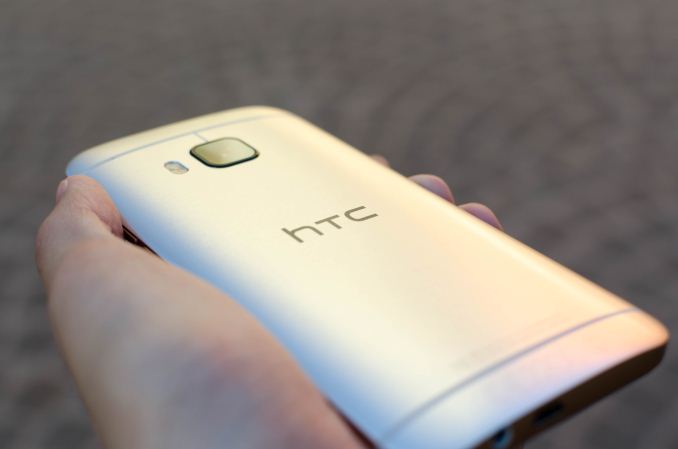
Read First: The HTC One M9 Review Part 1
A good amount of time ago, we posted part one of our HTC One M9 review, which gave a good idea of some critical aspects of the One M9’s performance and design. Unfortunately, due to HTC’s last minute software changes there was a need to redo some of our testing as the changes were quite significant for some key aspects of the user experience, which were effectively any situation where the SoC was in a thermally throttled situation and overall camera performance. I’ve finally finished redoing our testing of the One M9, so we can finish the review and get the full picture of the One M9’s performance. Normally, we’d start by discussing the design of the phone, but much of the review has already been finished with part one. Instead, we’ll start with sustained battery life tests.
Battery Life Continued
As previously detailed, our sustained battery life tests either strongly stress the CPU or GPU. For our GPU tests, we use GFXBench 3.0’s sustained GPU test, which runs the T-Rex benchmark on the display at its native resolution for an infinite rundown test. We didn’t have the modified test to present for a comparison between the two software builds, but we can get a pretty good sense for the changes that have occurred for final shipping software.
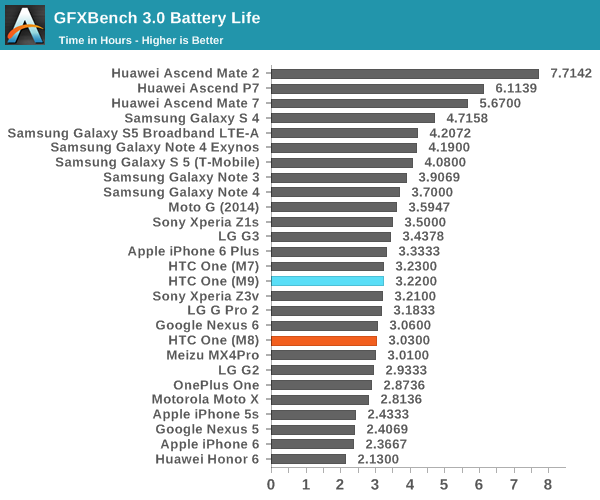
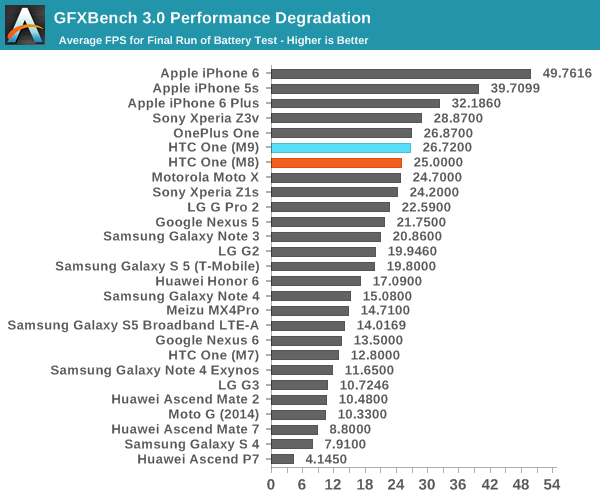
As one can see, the One M9 delivered somewhat impressive sustained performance with the pre-release build, but this resulted in almost dangerous skin temperatures and poor battery life on the order of 1.73 hours. The new update produced acceptable skin temperatures, but frame rate drops rather dramatically as skin temperature rises. The end performance actually ends up being quite similar to the One M8, but performance during the test is much higher than what we saw on the One M8.
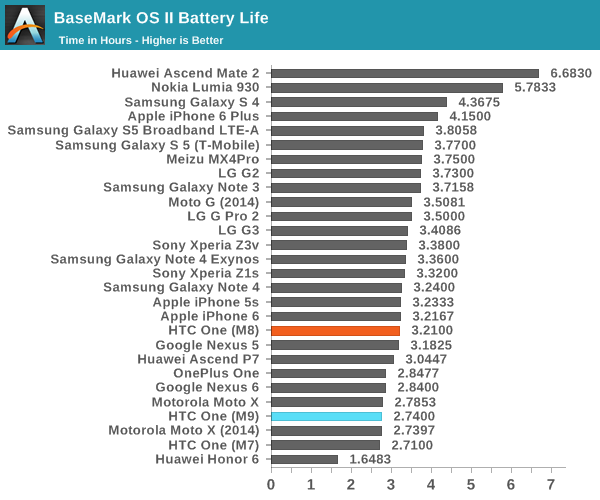

In the Basemark OS II test, we can see that the One M9 seems to perform poorly. One might be able to argue that the A57s provide more performance, but simple logging shows that past the first 20 minutes the A57 cluster is either shut down or throttled to the minimum clock state, although the A53 cluster manages to stay at 1.56 GHz for the duration of the test. For reference, the One M8 manages to keep the active CPUs at around 1.5 GHz throughout the test.
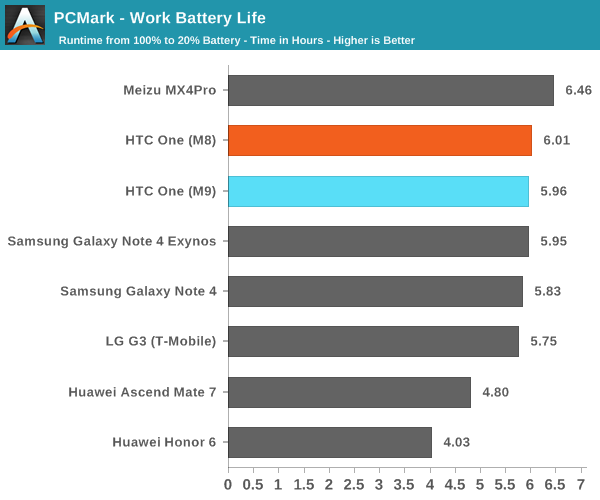
While Basemark OS II and GFXBench function as power virus tests, I wanted to get a good idea of performance somewhere between these rather extreme tests and the mostly display-bound web browsing test. To do this, I tested a few devices against PCMark’s work battery life benchmark, which shows that the One M9 seems to perform comparably when compared against the One M8. There is a noticeable difference in performance, but the gap isn’t all that big when compared to the M8. More interestingly is that the battery temperature sensor (which isn't necessarily on the battery) gets noticeably higher than the M8, on the order of 5-10C higher.
It’s a bit frightening to see that the gap in performance that we saw with the web browsing test remain. The effects of panel-self refresh would be greatly reduced in these short-running tests, so the differences here are mostly due to the SoC. The level of throttling I’ve seen here is pretty much unprecedented, which doesn’t help with the issue. Overall, the performance of Snapdragon 810 here is bad enough that I would genuinely consider Snapdragon 805 to be an improvement. I can’t help but wonder if this was inevitable though, as leaked roadmaps in the past suggested that Snapdragon 810 would’ve been a very different SoC.


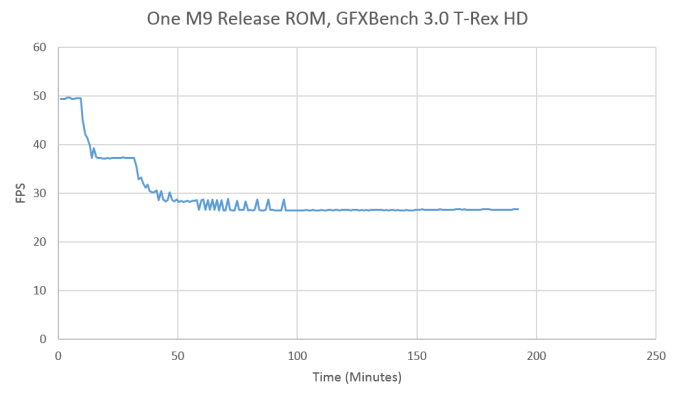
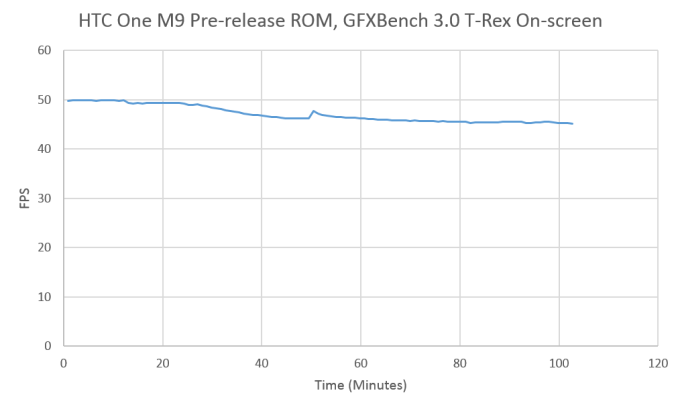








127 Comments
View All Comments
Speedfriend - Tuesday, April 7, 2015 - link
"The Android death knell sounds. "1bn people who purchased one last year disagree....
But if Microsoft could actually get its act together, it could take serious market share. Apple will never take the share as it is simply too expensive for 95% of android users.
mrochester - Tuesday, April 7, 2015 - link
I meant that Android leads to the eventual decline to bottom feeder status/death due to the platform being the same across all devices.jabber - Thursday, April 9, 2015 - link
So in that case Apple iPhone should be..what/where exactly?KoolAidMan1 - Thursday, April 9, 2015 - link
iOS is where it is now, which is the high end mobile platform where most developers, enterprise, games, apps, and paying users are.High end Android was always a niche but it was a niche with the potential to overtake Apple. Unfortunately for the last two years it has been a niche in decline. I mostly blame Google and Samsung. This BS from HTC is icing on the cake.
Quidam67 - Monday, April 6, 2015 - link
I don't often post on Anandtech but when I do it is because I've almost been moved to tears. I bought the HTC One M7 because I knew HTC was in trouble and I wanted to my tiny little bit to support a small company who had made a genuinely great phone. I skipped the M8 because upgrading every generation is just a bit silly on the pocket and because it was not muc of an upgrade anyway. I was looking forward to the M9 but this is a disaster of a product. Not only is not not better than the M8, it is not better than the M7. I can only see 2 things happening. Either they put out a revised Phone/model half way through this current generations life-cycle that dramatically fixes the glaring issues and/or offers something that stands out in the market, or they go to the wall and pheonix explodes into ashes, this time for good. RIP HTC.HangFire - Wednesday, April 15, 2015 - link
I couldn't have said it better myself.skells - Monday, April 6, 2015 - link
For the performance degradation chart, rather than having the average fps on the x axis, wouldn't it be better to have (% of initial fps during last test run) as it is an indication of the impact of thermal throttling and will be more comparable across devices.Dorek - Wednesday, April 8, 2015 - link
Seconded. That'd make much more sense.@siraltonstyles - Monday, April 6, 2015 - link
Wowza! How unfortunate. I've been team HTC since the G2. But, I will not be upgrading from my M8 to the M9. That thing has a faulty processor, a mediocre camera experience, a display that is lacking in pretty much every area, and uncompetitive battery life. I'll check it out in my local tmobile store and if it's actually better than the review states (which I doubt, cuz this is anandtech not bgr), I'll purchase it. If the review is dead on (which I expect it to be), I'll be purchasing the 64gb black S6. I hate to say this, but the M9 might be the nail in the coffin for HTCs Mobile business.Fidelator - Monday, April 6, 2015 - link
I'm really starting to believe that ARM found a gold mine with big.LITTLEI'm fairly sure they work hard to keep the performance to power consumption and heat generation ratio of A15/A57 cores well above anything sustainable on mobile designs based entirely on them
Therefore FORCING their partners to pay more per SoC since all SoCs now MUST use not 2 or 4 ARM cores but 6 and in most cases 8 cores after adding the necessary A7/A53 cores(and paying more for each extra one) to stay competitive.
I can hardly believe they keep thinking big.LITTLE is the best way to go considering how Apple's designs (and Qualcomms Krait as A15s competition) have proven to behave better while also keeping power consumption and heat generation in check.
Literally the ONLY big.LITTLE SoC that hasn't had inconsistent and unreliable performance is the Exynos 7420 and maybe, but to a much lesser extent the 5433.
I really hope to start seeing more custom cores soon.